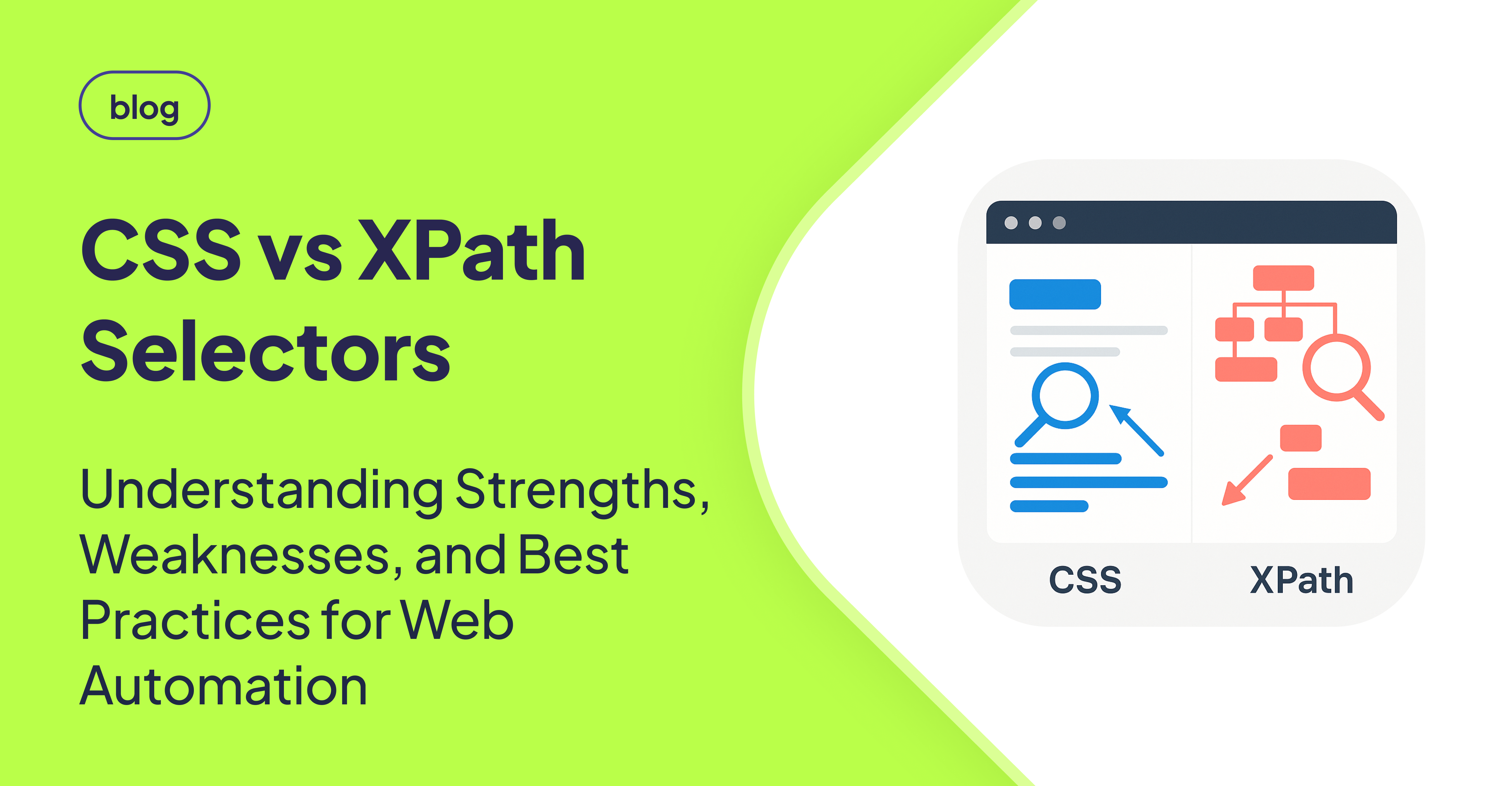TLDR
CSS selectors are generally faster and easier to use for simple web element selection based on attributes, classes, and IDs. XPath selectors offer more flexibility for complex scenarios like selecting elements based on text content or DOM position. Choosing the right selector and applying best practices like prioritizing unique IDs and managing selectors externally are crucial for building robust and maintainable automation scripts.
Introduction
Element locators are the bridge between automation scripts and web page elements, enabling actions like clicks and form filling. Accurate locators are critical for reliable automation. CSS and XPath selectors are two popular methods for locating elements, each with its strengths and weaknesses. Understanding these differences and applying best practices is key to building robust and maintainable automation scripts.
CSS Selectors: The Speed and Simplicity Option
CSS (Cascading Style Sheets) selectors target elements based on attributes, classes, IDs, and DOM relationships. Originally designed for styling web pages, they are now widely used in automation due to their readability, performance, and broad browser support. [STAT: Over 90% of web developers use CSS selectors daily for styling and other purposes.]
Key Advantages of CSS Selectors
- Readability: CSS selectors are generally easier to understand, particularly for web developers already familiar with the syntax.
- Performance: In many cases, CSS selectors offer faster matching algorithms compared to XPath. [STAT: Benchmarks show that CSS selectors can be up to 30% faster than XPath in some browser implementations.]
- Browser Support: CSS selectors are compatible with all major web browsers.
Example: Select a button with the class submit-button:
button.submit-buttonXPath Selectors: Unleashing the Power of DOM Navigation
XPath (XML Path Language) navigates the entire DOM (Document Object Model) tree, enabling selections based on element position, attributes, text content, and relationships. This makes XPath highly flexible for complex scenarios.
When to Choose XPath
- Flexibility: XPath handles complex scenarios that CSS cannot address, such as selecting elements based on their text content or position in the DOM tree.
- Precision: XPath can pinpoint specific elements within complicated DOM structures with greater accuracy.
- Dynamic Content: XPath is effective for locating elements with frequently changing attributes, as it can target elements based on other stable criteria.
Example: Select a button containing the text "Submit":
//button[contains(text(), 'Submit')]The Hidden Costs: Maintainability and Fragility
Both CSS and XPath selectors can suffer from maintainability issues and fragility if not implemented carefully.
- Maintainability Issues: Web pages evolve constantly, and changes in the DOM or attributes can break selectors, leading to test failures. [STAT: The average website undergoes significant UI changes every 3-6 months, impacting element locators.]
- Fragility Concerns: Selectors that rely on deep DOM paths or specific attributes are fragile and can break easily with even minor UI changes.
Best Practices for Building Robust Selectors
To mitigate these risks, testers should follow these best practices:
- Prioritize Unique IDs: Use element IDs whenever available, as they are less likely to change compared to other attributes.
- Keep Selectors Concise: Avoid overly complex or deeply nested selectors to reduce the risk of breakage.
- Use Relative Locators: Target elements based on their relationship to nearby stable elements, rather than relying on absolute paths.
- Manage Locators Externally: Store selectors in external files or databases to facilitate easier updates and maintenance. [STAT: Teams that centralize locator management reduce test maintenance time by up to 40%.]
CSS vs. XPath: A Detailed Comparison
| Feature | CSS Selectors | XPath Selectors |
|---|---|---|
| Main Function | Select by attributes, classes, IDs | Navigate DOM tree, select by text and relations |
| Performance | Generally faster | Slightly slower |
| Complex Conditions | Limited | Highly flexible |
| Text Content Selection | Not supported | Supported |
| Ease of Maintenance | Easier | Can be complex for deep DOMs |
Conclusion
Understanding the strengths and weaknesses of CSS and XPath selectors is essential for building reliable automation scripts. CSS selectors offer better performance and readability for simple selections, while XPath provides the flexibility needed for complex scenarios. By applying best practices, such as prioritizing unique IDs, keeping selectors concise, and managing them externally, testers can minimize fragility and ensure the long-term maintainability of their automated tests.
FAQ
When should I use CSS selectors over XPath?
Use CSS selectors when you need to select elements based on their attributes, classes, or IDs, and performance is a concern. They are also easier to read and maintain for simple selections.
When is XPath a better choice than CSS selectors?
XPath is preferable when you need to select elements based on their text content, position in the DOM tree, or relationships with other elements in complex scenarios where CSS selectors are insufficient.
How can I make my selectors more maintainable?
Prioritize using unique IDs for elements, keep your selectors as concise as possible, use relative locators to target elements based on their relationship to stable elements, and manage your selectors externally in files or databases for easier updates.
What are the risks of using overly complex selectors?
Overly complex selectors are more prone to breakage when the website UI changes, leading to test failures. They also make the automation scripts harder to understand and maintain.
Are there tools to help me choose the best locator?
Yes, many browser developer tools offer features to help you inspect elements and generate both CSS and XPath selectors. Experiment with both types to determine the most robust and maintainable option for each scenario.
